My Wife Wanted to Divorce Me Over Dinner, but Her Next Move Made Everything Worse


Hello distinguished guests and welcome to Aquarium Bright! Here, you will get to see the most dangerous sea and ocean creatures. But don’t let what I said mislead you! It’s very well possible for you to come across one of these underwater animals during a walk at the beach. So, take a look at them carefully now, and you might just avoid a disaster.
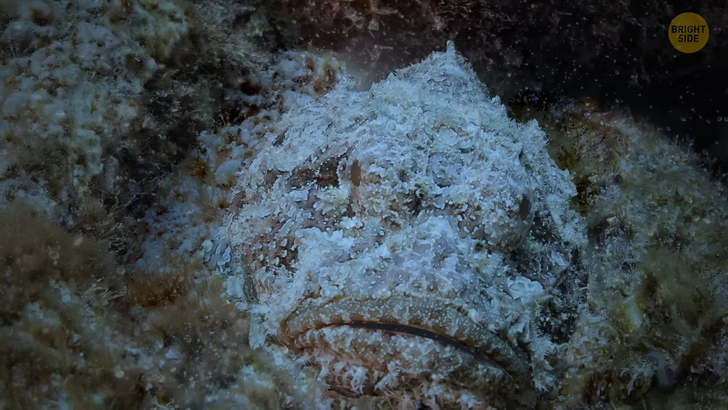
Is it fish or is it stone? What you are looking at is commonly known as the stonefish, but its fancier names include “The Dornorn” and “Synanceia”. If you are into diving and observing the underwater you might already have come across one without noticing. Its appearance makes it almost impossible to distinguish it from a real stone due to its gray coloration and mottled appearance. Especially if you’re wearing fogged snorkel goggles... So, you better pay attention because otherwise, the consequences can be unfortunate since stonefishes are the most venomous fish known.
Although some types of stonefishes are known to live in rivers, most of them are found in coral reefs near the tropical Pacific and Indian Oceans. Their needle-like dorsal fin spines stick up when they are disturbed or threatened, and inject the poison they contain. The most common reason why stonefish stings occur is swimmers stepping on them without realizing it. However, you don’t need to be in the water to get stung. Since they can survive out of the water for up to twenty-four hours, you will have to watch where you step when you’re at the beach as well.
Those who got stung by stonefish describe their experience to be extremely distressing. Their venom can result in infection. And in some cases, it is known to cause shock and paralysis. It might come as a bit of a shock but despite its bad reputation, stonefish is edible if it is prepared properly. When the fish is heated, its venom breaks down. And if the dorsal fins, which are the main source of its venom, are removed, raw stonefish is served as part of sashimi, too.
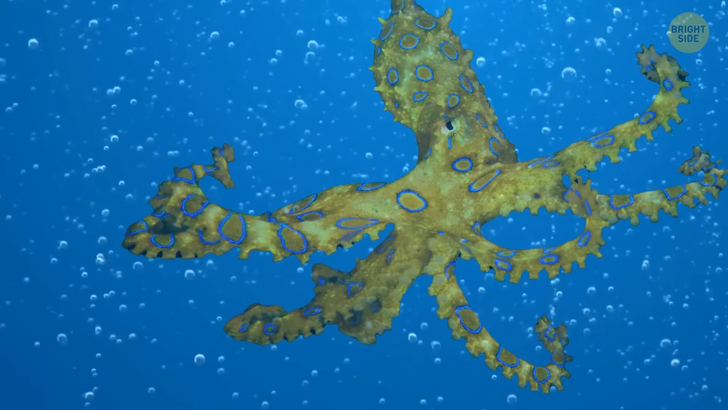
This creature might look like it came out of a science-fiction movie, but it’s very much real! Say hello to blue-ringed octopuses! Don’t be deceived by their small size, which can range between 5 and 8 inches including their arms, because they are packed with venom to cause great damage to as many as twenty-six people within minutes! Just like stonefishes, blue-ringed octopuses are found in the Pacific and Indian oceans, from Japan to Australia. They typically live on coral reefs and rocky areas of the seafloor. Some may also be found in tide pools, seagrass, and algal beds.
Blue-ringed octopuses are not aggressive in nature. When they are not seeking food, such as crabs and shrimps, or searching for a mate, they often hide in marine debris, shells, or crevices. It is only if they are provoked, cornered, or handled that they get dangerous to humans.
When they are threatened, they turn bright yellow, and blue iridescent rings appear all over their body as a warning display towards the potential predators. Their bites usually come unnoticed, so you might not be able to realize you’re bitten until it’s too late. The venom of a blue-ringed octopus can cause dizziness and loss of senses and motor skills, and ultimately paralysis. So, better try to keep your hands to yourself and back away in a hurry if you see one.
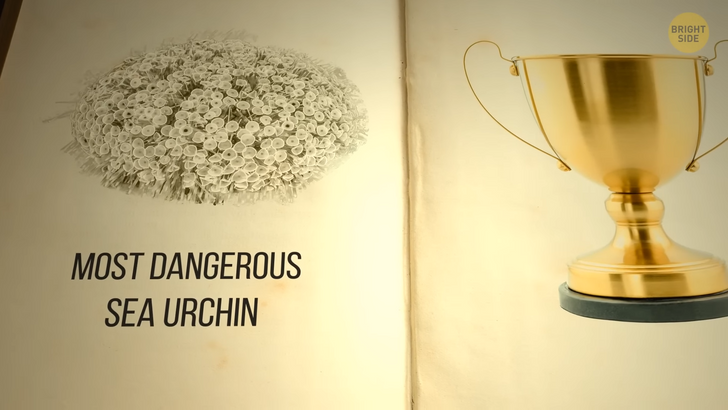
Nope, it’s not a flower bouquet... So, don’t try to pick and smell one of those pink tube-like things...! What’s standing before your eyes is a marine animal called a flower urchin. It may look gorgeous, but don’t let the looks deceive you. It was named the most dangerous sea urchin in the 2014 Guinness World Records. Flower urchins inhabit the tropical areas of the Indo-West Pacific and are found among coral reefs, rocks, sand, and seagrass beds at depths of 0 to 295 feet.
The most noticeable feature of them is their pedicellaria, which are claw-shaped defensive organs that are also found in sea stars. What makes flower urchins differ from any other sea urchin is the fact that their pedicellaria is, as the name suggests, flower-like and usually pinkish-white to yellowish-white in color with a central purple dot. Hidden underneath these “flowers” they possess short and blunt spines.
Although many sea urchins deliver their venom through such spines, flower urchins deliver their venom through their pedicellaria or “flowers”. If they are undisturbed, the tips of these flowers are usually expanded into round cup-like shapes. On their surfaces, they possess tiny sensors with which they can detect threats. And once they contact such threats, these flowers immediately snap shut and start injecting venom. What’s weird is that the little claws of the flowers can sometimes break off from their stalks, stick to the point of contact, and continue injecting venom for hours into whoever touched it.
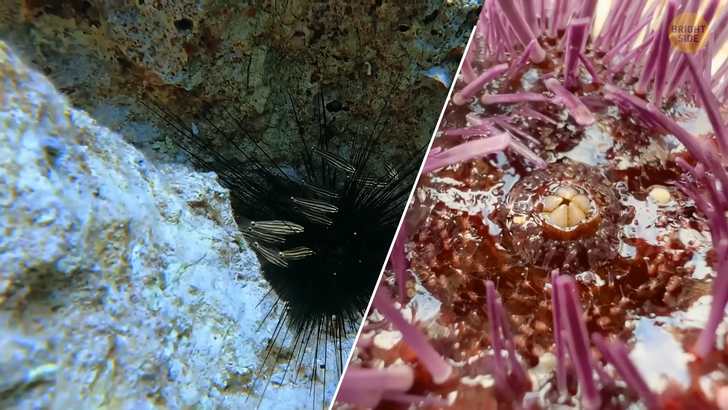
Looks like a giant puddle of melted raspberry ice cream, right? You wish... It’s a lion’s mane jellyfish, which is also called giant jellyfish, arctic red jellyfish, or hair jelly. They are known to prefer cool water. That’s why they can mostly be found in the Arctic, northern Atlantic, and northern Pacific Oceans. But it’s possible to spot them around the Britain Isles and in Scandinavian waters, too. Lion’s mane jellyfish are one of the largest known species of jellyfish.
They get their name from their long flowing hair-like tentacles that can reach lengths up to 10 feet. And although the average bell diameter of a lion’s mane jellyfish is around 20 inches, they can sometimes attain a diameter of over 7 feet. The largest lion’s mane jellyfish recorded was seen in 1865 off the coast of Massachusetts. It was measured to have tentacles around 120 feet long and a diameter of 7 feet. To help you picture it, this is longer than a blue whale!
Lion’s mane jellyfish hunt by extending their tentacles outward and creating a trap to catch their food. Since they have around one thousand two hundred stinging tentacles, the fish would have to be extremely lucky to be able to escape them. The sting of a lion’s mane jellyfish is usually not life-threatening, but you would still want to avoid swimming into its tentacles because it can be very painful to humans. And if you see one washed up on the beach, better not touch it since it can still deliver a sting long after they’ve been on the shore.
Fun fact: the lion’s mane jellyfish appears in the Sherlock Holmes story “The Adventure of the Lion’s Mane” as a suspect. But don’t worry, we won’t give any spoilers!
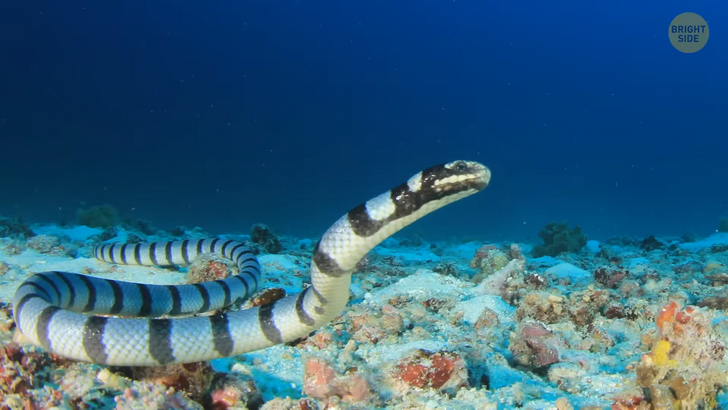
The last marine animal you’re seeing now is a sea snake! And yes, they are different from eels... There are sixty-nine identified species of sea snakes. Most of them can be found in the tropical and subtropical waters of the Indian and Pacific Oceans, and they have been around for millions of years.
To make things easier, scientists have separated all different species of sea snakes into two categories: true sea snakes and sea kraits. Whereas true sea snakes spend almost all their time at sea, sea kraits can spend some time on the land as well. If you see a snake on the beach, you can tell whether that is a land or a sea snake by looking at its tail. If it’s paddle-like, then that’s a sea snake you got there! But make sure to keep your distance in both cases...
All sea snakes need to surface regularly to breathe since they have no gills. That’s why you can come across one while swimming. If that happens, you better swim away as fast as you can because most sea snakes have more venom than the average cobra or rattlesnake. However, since they only attack if provoked, bites are quite rare. One more cool fact about sea snakes! They are the only reptiles to give birth in the oceans!
The majority of sea snakes keep the eggs within themselves and give birth to nearly fully formed snakes while swimming. That is except for the yellow-lipped sea krait though. They come onto land to lay the eggs of their little ones. Remember the stonefish from the beginning of our tour? They are hunted by sea snakes! Blame the food chain...











